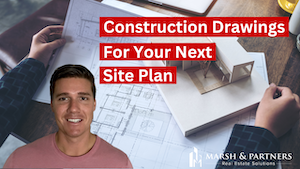Construction Cost Management on Your Next Commercial Development Project
Real estate developers have a lot to contend with. Local municipalities and government agencies are constantly changing rules which adds complexity to projects. Consultants, tradesmen, and contractors are harder than ever to manage. Combine that with the fact that projects take longer and cost more money today than at any other time in history, and you have a recipe for major challenges.
Proper construction cost management is one of the most important skills a developer should possess. Managing costs happens throughout the entire real estate development process - it starts during pre-development and project design - an overly designed building is always going to cost more than you budget for. And it continues throughout land entitlement, permitting, construction, and even post-construction.
In this video, we discuss the different kinds of construction costs a developer will see during a project - hard and soft costs or direct and indirect costs. And we highlight some industry best practices for construction cost management as it applies to the various stages of the real estate development process.
Guide to the video
- Managing construction costs can't be left up to chance. It needs to be an intentional aspect of a well-rounded commercial real estate development business plan
- Real estate developers that train in the skill of cost management and hold their project consultants accountable will be much better positioned to win against their competition
- The best time to manage construction costs happens during pre-development and project design
Video transcript follows
The built environment around us may seem like a recent invention, but civilizations have been building real estate for thousands of years. And even thousands of years ago, project stakeholders were looking for ways to make their construction more efficient – reducing costs while also maximizing the resulting outputs.
Today construction cost management is a huge challenge. Real estate development has only become more complex - global markets and macro economies more intertwined and volatile, and municipalities more cumbersome to get projects approved and permitted. Projects require more planning than ever and because successfully executing on a commercial real estate development requires a lot of things to go right.
So, one of the ways that real estate developers are trying to stimulate success is through deliberate construction cost management. It’s not something that should be left up to chance.
In this video, I am going to cover some tips and tricks cost managing construction costs – from pre-development through construction and post-construction.
----------
What’s up everyone – it’s Matt Marsh with Marsh & Partners.
Marsh & Partners is a development and national consulting firm that helps business owners and investors maximize their real estate and transform their businesses.
If you’re enjoying what we’re doing here, and want to keep seeing more content like this, please hit that like button and share this video and our other videos with people you think might find some value in them.
Understanding the different kinds of construction costs
In order to manage construction costs, it’s important to be able to differentiate between the different kinds of costs you encounter during a project.
Costs can be broken down into a couple of different categories – hard vs. soft costs or direct vs. indirect costs.
Hard or direct costs are the expenses directly related to the physical construction of a property. Items like construction materials and labor, any equipment, subcontractors, and all the work associated with the land development are considered hard costs.
Conversely, indirect, or soft costs, are not directly tied to construction, but are equally as important to a project. Things like architectural and engineering expenses, review and permit fees, legal, financing, and administrative costs are all examples of soft costs.
But the reason it’s important to understand the different kinds of costs you’ll encounter during a project is because of how your project’s design and soft costs will impact the overall budget.
I am going to dig into that a little deeper now.
Managing construction costs during project design and pre-development
The pre-development phase of a commercial real estate project is critical to the success of the development. It’s where all the real estate due diligence, feasibility, planning and land entitlement activities happen, and when the architectural drawings design is fleshed out.
It’s important to note that all of the design work, including the site plan and any building plans, will impact how much the project costs. If your cost conscious, and construction cost management is a major goal of the commercial real estate project, those details will need to be worked out early in the project.
So as a real estate developer, you need to clearly define the scope of the project and identify any critical objectives and requirements early to avoid overly designing a property. Once the scope is defined, it’s important to establish a realistic budget. That budget will help guide the design for the entirety of your project.
The budget should be created with critical cost drivers in mind. For instance, in some projects, the site itself may present major challenges, and the earthwork will likely be the major cost driver. You may need to import a lot of fill dirt, or blasting is required, or stormwater detention needs to be migrated underground, or maybe the site’s topography requires extensive retaining walls. Accurately estimating sitework and land developing costs will be helpful when making these decisions.
Sometimes instead of the site characteristics being a major cost driver, the location of the land could be. Parcels in highly desirable areas, based on critical site selection fundaments, will be more expensive than land in less desirable locations.
Additionally, depending on the municipality, the application, development, permit, and impact fees can vary greatly. You’ll want to account for these as you create your real estate development budget. By identifying the major cost drivers through the project, you’ll be able to isolate those expenses and focus design efforts around minimizing them.
During pre-development, the design efforts are usually managed by the civil engineer for site design and the architect will manage the floorplan and building elevations.
Keep in mind that architects are wonderful project partners, but many aren’t good with cost control or cost estimation. I’ve seen too many projects go off the rails because of overzealous architects and poor design management.
It can be helpful to get a general contractor involved in the pre-development and design process early to help. They’ll have insight into construction and materials costs and will be able to assist in project value engineering or helping control design.
Design optimization is a critical component of construction cost management. It’s important to periodically estimate construction costs during this process to make sure you’re on track and within budget. Project owners should consider getting their commercial real estate development plans priced at a couple of milestones – normally I suggest after schematic design, at several points during design development, and when the full construction drawing set is complete for the architectural drawings.
Obviously, all these strategies are easier said than done. It’s common that once a project gets started, it begins to take on a mind of its own. As a real estate developer or project manager, your role is to orchestrate the different consultants and third parties and make sure everyone is rowing in the same direction according to your vision.
Managing construction costs begins during the pre-development phase of a commercial real estate project. But it doesn’t end there. Once you’re complete with land entitlement and preparing to break ground, there are ways to continue to refine your processes and manage costs.
I’ll talk about those next.
Construction cost management during development
If you didn’t select a general contractor during pre-development, that’ll be the first focus here. A contractor will be your linchpin when it comes to cost-effective material procurement and vendor or subcontractor selection.
COVID showed us that supply chains are fragile. And disruptions to supply chains cause major ripples across commercial real estate development projects. A contractor can help you anticipate long lead materials, schedule early release packages, and make sure materials are sourced within budget.
Too many projects have become derailed because of long lead items that have delayed CO’s even after construction is complete. That translates to increased carrying costs and lease-up timeline delays that can absolutely blow up a proforma.
Recent AI advancements have made procurement more efficient and should be leveraged to assist with construction cost management.
Now when selecting a contractor, it’s important they have a track record of selecting quality subtractors. The subcontractors are the ones on the site daily and doing the work, so you should solicit bids from several vendors to ensure you’re getting good value for their efforts.
But both material procurement and subcontractor selection all starts with finding the right GC - a contractor that places an emphasis on value engineering and efficiency. Real estate developers need to be anal about the contract they negotiate with their GC. Time & materials, cost plus percentage, and fixed fee contracts are several different types of fee arrangements a developer might see. Each structure has pros and cons but will impact the contractor’s incentive to be cost-conscious.
The most important thing to remember when negotiating a contract with a GC is to best align their incentive structure and fees with timely and cost-efficient project delivery.
Once construction begins, effective construction cost management becomes even more critical. Developers should be tracking costs in real time. Don’t simply rely on a contractor to do it for you – request regular expense ledgers and invoices so you can reconcile expenses and ensure construction budget compliance.
You’ll also want to avoid project change orders as much as possible during construction. In some cases, they’re inevitable. But if you were diligent during pre-development, and made sure the construction documents were detailed and comprehensive, you’re much more likely to minimize expensive changes.
But probably the most important step to managing construction costs during this phase is simply communication. Regular project meetings with contractors and stakeholders will keep the team on the same page but also offer opportunities for collaboration and real time feedback on ways to maximize efficiency.
Construction cost management post-construction
Once a project is finalized, the contractors punchlist complete, and a certificate of occupancy issued, the job still isn’t done.
Capturing lessons learned and self-auditing the entire pre-development and construction process is important to refining and implementing new cost management strategies.
In the Army, we used to call these after-action reviews. But the premise is that while we might not be able to turn time back and undue mistakes for this project, we can certainly outline improvements for the future.
Effectively managing construction costs requires planning and continuous reflection and refinement. As a developer, being self-critical is important because it allows for professional growth and can enhance cost management practices.
Key takeaways
Real estate developers spend decades and many projects codifying their construction cost management practices. Despite anyone’s best efforts, it’s impossible to control all aspects of a project. But you can implement left and right limits on your designers during pre-development to optimize project design. And on your contractor during material procurement and construction to focus their efforts on value engineering.
These cost management strategies are all suggestions based on industry best practices. You don’t want to wait until construction begins to try and start managing costs. Instead, it starts during the first scope meeting you have with the civil engineering team.
None of this is to say that every aspect of a project needs to be optimized simply for the sake of reducing costs. Small businesses still need facilities to be practical and to complement their operations. And developers still want to create unique destinations that people enjoy.
But as long as cost decisions are considered, your project is much more likely to be successful.
A real estate development consultant can help stakeholders manage the fine line between aesthetics and efficiency. And it starts with assembling the right development team based on the project goals and objectives.
From managing design professionals, to helping implement systems to track expenses, to helping value engineer commercial real estate development design, Marsh & Partners can help assist on your next project.
We’re developers by trade, but enjoy working with growing small businesses and other real estate developers looking to create the future of the built environment.
Check out our real estate consulting services to learn more about how we might be able to help.
----------
If you enjoyed this video hit the like button and subscribe to our channel to stay up to date on content to help you through your real estate journey.
You can also check out our site for more real estate insights at marsh-partners.com.
Feel free to leave us a comment if there are any other topics you’re interested in or would like us to cover.
Don’t forget to subscribe if you want more content like this and thanks for watching.



